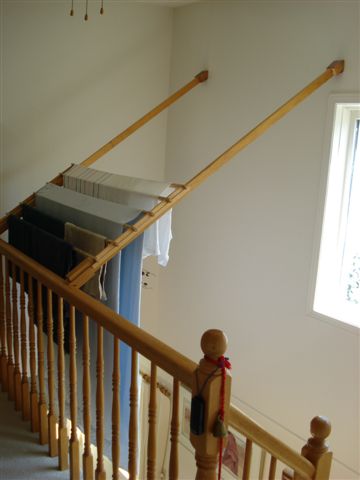Dunbarton Dryer
by Mark Sunderland
The Dunbarton Dryer is a clothes drying rack that addresses the substantial volume of unusable real estate above a townhouse stairwell.
The Dunbarton Dryer is completely removable and easily stored when itûôÂûÂãô˜ûÂãôÂs not in use. When nothing is hanging on it, it is fairly inconspicuous and, being made of wood, it is not incongruous with the surrounding area. Here, the laundry room is immediately on the opposite side of the landing.
During the past 10 years, the Dunbarton Dryer has completely obviated the need for a mechanical clothes dryer in this household and, since it is constructed from used materials, it has more than earned its keep. (One-inch wooden dowling normally used for mop handles can frequently be found in the garbage when the mop ends are spent.)
Two 1ûôÂûÂãô˜ûô x 2.5ûôÂûÂãô˜ûô laths span the stairwell from the landing rail to the opposite wall at an angle of about 45 degrees. The racks, supported by the laths, each have six horizontal dowels on which to hang sheets, towels or clothing.ûãûô Towels that are hung on it will generally dry overnight.
Additional racks can be added and pushed up the inclined buy antibiotics no prescription laths to gain more drying space.
The case against the mechanical clothes dryer: It is the only domestic appliance that serves no purpose other than to save, we think, time. The stove, the fridge, the dishwasher, the vacuum cleaner and clothes washer all do a job that time alone canûôÂûÂãô˜ûÂãôÂt do. Time alone canûôÂûÂãô˜ûÂãôÂt heat a meal nor make an ice cube, for example, but the drying of clothes doesnûôÂûÂãô˜ûÂãôÂt need mechanical assistance ûôÂûÂãô˜ûÂã˜ô you can just let them hang out to dry.
The soft costs of time for any appliance are the hours we work to pay the capital cost, the delivery, the operating costs and the ultimate removal and destruction. With the clothes dryer, we can add the cost of accelerated clothing replacement.
In addition to its 22 cubic feet of uselessness (exhaust pipe not included), a clothes dryer needs a single-phase 3-wire electrical connection to chew up our clothing into lint and exhaust our warm air at a monstrously high rate of dollars per hour.
4 July, 2008


